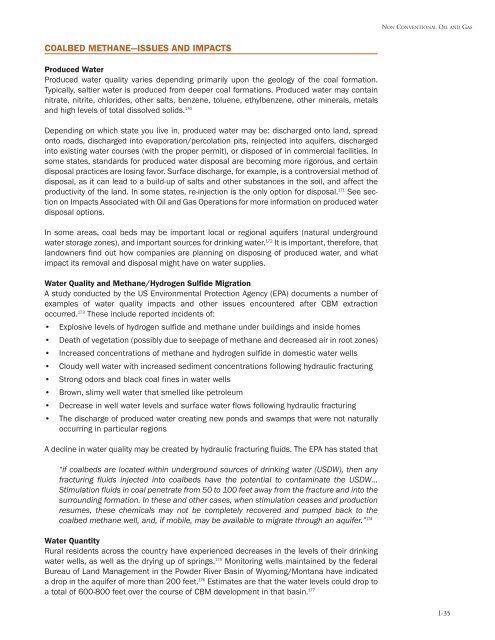Oil and Gas at Your Door? (2005 Edition) - Earthworks
Oil and Gas at Your Door? (2005 Edition) - Earthworks
Oil and Gas at Your Door? (2005 Edition) - Earthworks
Create successful ePaper yourself
Turn your PDF publications into a flip-book with our unique Google optimized e-Paper software.
NON CONVENTIONAL OIL AND GAS<br />
COALBED METHANE—ISSUES AND IMPACTS<br />
Produced W<strong>at</strong>er<br />
Produced w<strong>at</strong>er quality varies depending primarily upon the geology of the coal form<strong>at</strong>ion.<br />
Typically, saltier w<strong>at</strong>er is produced from deeper coal form<strong>at</strong>ions. Produced w<strong>at</strong>er may contain<br />
nitr<strong>at</strong>e, nitrite, chlorides, other salts, benzene, toluene, ethylbenzene, other minerals, metals<br />
<strong>and</strong> high levels of total dissolved solids. 170<br />
Depending on which st<strong>at</strong>e you live in, produced w<strong>at</strong>er may be: discharged onto l<strong>and</strong>, spread<br />
onto roads, discharged into evapor<strong>at</strong>ion/percol<strong>at</strong>ion pits, reinjected into aquifers, discharged<br />
into existing w<strong>at</strong>er courses (with the proper permit), or disposed of in commercial facilities. In<br />
some st<strong>at</strong>es, st<strong>and</strong>ards for produced w<strong>at</strong>er disposal are becoming more rigorous, <strong>and</strong> certain<br />
disposal practices are losing favor. Surface discharge, for example, is a controversial method of<br />
disposal, as it can lead to a build-up of salts <strong>and</strong> other substances in the soil, <strong>and</strong> affect the<br />
productivity of the l<strong>and</strong>. In some st<strong>at</strong>es, re-injection is the only option for disposal. 171 See section<br />
on Impacts Associ<strong>at</strong>ed with <strong>Oil</strong> <strong>and</strong> <strong>Gas</strong> Oper<strong>at</strong>ions for more inform<strong>at</strong>ion on produced w<strong>at</strong>er<br />
disposal options.<br />
In some areas, coal beds may be important local or regional aquifers (n<strong>at</strong>ural underground<br />
w<strong>at</strong>er storage zones), <strong>and</strong> important sources for drinking w<strong>at</strong>er. 172 It is important, therefore, th<strong>at</strong><br />
l<strong>and</strong>owners find out how companies are planning on disposing of produced w<strong>at</strong>er, <strong>and</strong> wh<strong>at</strong><br />
impact its removal <strong>and</strong> disposal might have on w<strong>at</strong>er supplies.<br />
W<strong>at</strong>er Quality <strong>and</strong> Methane/Hydrogen Sulfide Migr<strong>at</strong>ion<br />
A study conducted by the US Environmental Protection Agency (EPA) documents a number of<br />
examples of w<strong>at</strong>er quality impacts <strong>and</strong> other issues encountered after CBM extraction<br />
occurred. 173 These include reported incidents of:<br />
• Explosive levels of hydrogen sulfide <strong>and</strong> methane under buildings <strong>and</strong> inside homes<br />
• De<strong>at</strong>h of veget<strong>at</strong>ion (possibly due to seepage of methane <strong>and</strong> decreased air in root zones)<br />
• Increased concentr<strong>at</strong>ions of methane <strong>and</strong> hydrogen sulfide in domestic w<strong>at</strong>er wells<br />
• Cloudy well w<strong>at</strong>er with increased sediment concentr<strong>at</strong>ions following hydraulic fracturing<br />
• Strong odors <strong>and</strong> black coal fines in w<strong>at</strong>er wells<br />
• Brown, slimy well w<strong>at</strong>er th<strong>at</strong> smelled like petroleum<br />
• Decrease in well w<strong>at</strong>er levels <strong>and</strong> surface w<strong>at</strong>er flows following hydraulic fracturing<br />
• The discharge of produced w<strong>at</strong>er cre<strong>at</strong>ing new ponds <strong>and</strong> swamps th<strong>at</strong> were not n<strong>at</strong>urally<br />
occurring in particular regions<br />
A decline in w<strong>at</strong>er quality may be cre<strong>at</strong>ed by hydraulic fracturing fluids. The EPA has st<strong>at</strong>ed th<strong>at</strong><br />
“if coalbeds are loc<strong>at</strong>ed within underground sources of drinking w<strong>at</strong>er (USDW), then any<br />
fracturing fluids injected into coalbeds have the potential to contamin<strong>at</strong>e the USDW…<br />
Stimul<strong>at</strong>ion fluids in coal penetr<strong>at</strong>e from 50 to 100 feet away from the fracture <strong>and</strong> into the<br />
surrounding form<strong>at</strong>ion. In these <strong>and</strong> other cases, when stimul<strong>at</strong>ion ceases <strong>and</strong> production<br />
resumes, these chemicals may not be completely recovered <strong>and</strong> pumped back to the<br />
coalbed methane well, <strong>and</strong>, if mobile, may be available to migr<strong>at</strong>e through an aquifer.” 174<br />
W<strong>at</strong>er Quantity<br />
Rural residents across the country have experienced decreases in the levels of their drinking<br />
w<strong>at</strong>er wells, as well as the drying up of springs. 175 Monitoring wells maintained by the federal<br />
Bureau of L<strong>and</strong> Management in the Powder River Basin of Wyoming/Montana have indic<strong>at</strong>ed<br />
a drop in the aquifer of more than 200 feet. 176 Estim<strong>at</strong>es are th<strong>at</strong> the w<strong>at</strong>er levels could drop to<br />
a total of 600-800 feet over the course of CBM development in th<strong>at</strong> basin. 177 I-35




